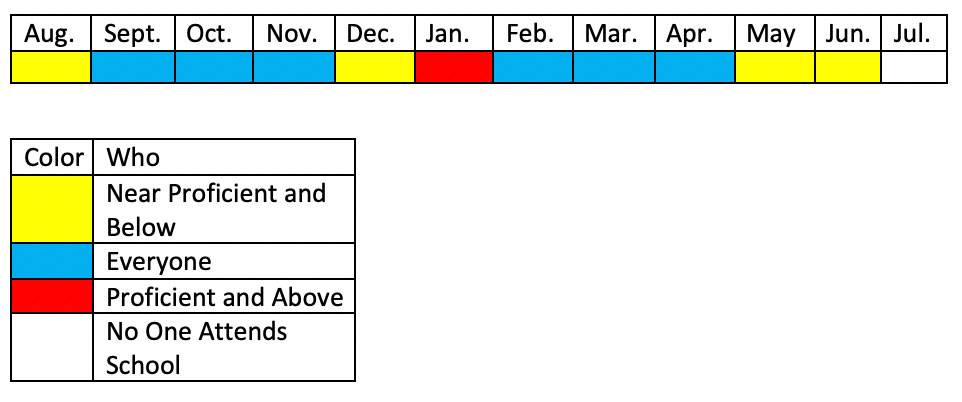Be Visionary: 6 Ways the Corona Virus Outbreak Offers the Perfect Opportunity to Bring Real Change to Education
4/2/2020

This year a triple murder occurred in my community and adjacent to my school which caused a closure… we then had a district wide closure for a bomb threat… and now a closure for the Corona Virus.
To say my school has been hit hard by school closures this year is an understatement. The Corona Virus is teaching us a lot about ourselves as teachers, as leaders, and we are finding holes in a lot areas of the education we are providing our students.
There are a huge number of variables that leaders must weigh before a school closure is considered. A weather event, a health situation, or a safety concern are all the major reasons a school typically closes. It seems these events are occurring back to back. This should be a sign that we need to rethink and reenvision our approach to schooling.
In society's mind, the perception still persists that students come into a classroom, sit in a row of hard desks attached to chairs, listen to a teacher who stands in the front of the room lecturing before doling out tons of homework…in fact, the more homework, the better! This concept couldn't be further from the truth of what we now know about best practices for our students.
This article is not about what education looks like currently, it is more about what it should look like in the future.
When we reenvision education, and we need to so immediately, there are six facets that I believe need to change.

1 - All Communities Linked by the Great Wireless Highway
In the last one hundred years we have built beautiful new highways, interstates, and other roadways across America. We have even built a highway in Glacier Park, called Going to the Sun Highway, on the side of a rock wall where you could plummet thousands of feet below on one side, while the other side a weeping wall of water splashes down on drivers in the spring. This was a modern miracle built in the early 1900's in Glacier National Park. The road took eleven years to build with another four years of preparation and planning.
Well, why can't we do the same with building wireless virtual highways across all the communities in the United States? Wireless capabilities should be accessible to all American citizens, and more importantly, OUR KIDS!
Can you imagine what our communities could do in education for all students, and even adults, if we had free wireless access to the internet even in small outlying communities?
Access to education would become a way of life for all Americans as there would be no excuse for not developing 21st century job skills the same way we're able to use Google now to access information on anything - immediately! This is an equity issue our federal government must fix!

2 - All School Supplies Should Be Paid for Including 1:1 Devices For All Students
Each year a societal inequity is celebrated in stores like Target, Walmart, Staples, and more…the School Supply Season. The purchasing of school supplies is one of the most difficult concepts to understand when you think children deserve a Free and Appropriate Public Education (FAPE).
We ask parents to buy school supplies for their child before the school year starts every fall. To further the inequity, some schools ask their students to bring more than what is asked for in other schools, and this usually parallels the socio-economic status of the school community.
The founding fathers of our nation believed public education should be free and that our nation's residents should be educated to a certain standard and at a certain level. This founding principle is still evident today. School supplies are part of meeting that standard, so the federal government needs to fund education appropriately so we don't have to ask students to bring these supplies to school each fall.
We also need to get into the 2020's! Everyone, almost everyone, has some type of device they can use to access the internet. Yet, some of our kids do not. If you look at our federal spending across the nation and the world, you will see areas where the priority could and should be shifted. This shift in resources would cover a device as a normal school supply for all students in America. Are you telling me we can land the Mars Rover, yet we can't pay for a device? Every student could then access the internet while at school, and home.

3 - Breakfast and Lunch Should Be Free
In my educational career, we have gone from having a hot lunch served, to making sure students have breakfast, and some schools even serve a third meal every day in their communities. You may argue that food was never part of the educational responsibility of a school, but it's actually a generations-old cause first enacted in 1946 when Truman signed the National School Lunch Program Act. Today, 74 years since its inception, we must rethink our attitudes about feeding students and look at food as a necessity for effective learning.
I am a firm believer of Maslow before Bloom. This means I believe we should be meeting the basic needs, or Maslow's Hierarchy of Needs, before being able teach our students using Bloom's Taxonomy of Learning. In essence, we must feed students before they can learn. All educators know that a student has a difficult time learning when their stomach is hurting from not meeting their nutritional needs.
The No Kid Hungry - Breakfast After the Bell movement across the nation has helped meet a need for students who are not getting proper nutrition in the morning. The bell rings, then students eat breakfast. In the past, breakfast was served before school, requiring students to show up early. Schools were missing a large portion of students who needed breakfast. In my school, over 60% of our students take part in Breakfast After the Bell.
Let's take it one step further. All students should receive breakfast and lunch for free. Taking the price of food off the table will help ensure all students are getting nourished so they can learn! Federal and state governments should make this a priority.

4 - Seat Time Vs. Proficiency
This may be the most complex concept out of all the reasons to reenvision education that I'm presenting here. Currently, we ask students to attend school 180 days, or 1,080 hours in most school districts across the nation. If these numbers are different, they all evolve around the concept of seat time. Seat time refers to the number of hours or days a student is at school and on campus. Yes, they may not be seated, but they are physically at the school.
We know that attendance matters. We know that students who attend school more routinely are more proficient. In fact, you will find studies that show that attendance has a direct correlation to graduation and future success. In any case, we can find outliers in these studies that do not fit the typical scenario and mathematical equation. Some students may not attend school regularly, but they are still proficient in their academics.
How do these students do it? Some of our students learn outside the walls of school, or are simply able to comprehend and assimilate information easier with less time in the classroom. Unfortunately, we have many students across the nation who need more time or miss school frequently and need more opportunities to demonstrate proficiency. The current model is not working for them, and I believe we can reconfigure and reenvision a new model for education…a model built on real demonstrable proficiency instead of rote recitation.
The current model of education was developed during the industrial revolution and has incorporated some of the successful facets of industrialism. In a certain sense, the education model feels a lot like the model for industrial scale mass production. We teach the masses of students a concept, mostly in one fashion, and then switch them from room to room to insert new material. We do this for 180 days, then we send them on to the next grade level to do the same thing. From Kindergarten to twelfth grade, students are cycled through this experience 13 times before heading out into the world.
We need to move to a proficiency model for educating our students. The standards based movement in education is a great start. Each grade level has specific standards and students are working towards proficiency in each of these standards. I believe we need to blur the lines that delineate grade levels and stop thinking of the learning process in terms of seat time.
Here is a graphic representation of which students would attend school at different times of the year based on the proficiency model I have in mind.

Students identified as yellow, nearing proficiency or below, will attend school 10 months out of the school year, with four months in small class sizes with only this group on campus at that time. They will be given adequate start time in the beginning, which may be extensive review and preview of content in August each year. They are then more prepared to start the school year with all students in September when they receive targeted interventions with adequate resources and personnel.
Students identified as red, or proficient and above, will attend school seven months out of the school year. Six of those months they will be combined with everyone on campus. One month these students will be on campus by themselves. With small class sizes, this month-long period could quickly expand and broaden their learning.
This model is for an 11-month school year. Teacher's contracts would need to be negotiated accordingly.
The goal of this model is to make sure students are receiving the proper instructions, interventions, resources, and staff members to improve achievement and increase proficiency. This model is based on proficiency and not seat time. Students may move between groups as needed in order for students to get what they need.
We also need to look at synchronous and asynchronous learning. Synchronous learning occurs at a specific time and day. Asynchronous learning is generally associated with online learning, allowing students to access study materials at any time that is convenient to them. I believe we need a balance of these two types of learning formats, as well as blended learning. As an adult, I recently learned how to take off the hard top of my jeep, and then replace it with my soft top. I was able to watch someone on YouTube demonstrating how to do it. I will not lie, I watched that video multiple times, and backed it up to watch specific sections frequently. Shouldn't we have multiple opportunities to learn something until we are proficient? This is a huge argument for a proficiency learning model!
This is just one proficiency model for a school year. There are many other models similar to this that have been proposed. Educational policies will need to be changed, societal and culture shifts will need to occur, but without them, we will continue the same industrial age model we currently have in place. Yes, I foresee much trouble-shooting and hurdles to overcome, but we must reenvision what education could be by basing our learning on proficiency!

5 - Emergency Protocols for School Campus Closures
Many districts practice emergency protocols across the nation. These protocols are set in place to keep everyone safe, as well as getting people to move to safety more effectively and efficiently. We also are now creating new protocols for closures like bomb threats, crime in our communities, and now sicknesses and pandemics.
Even when we close our school doors, our instructional doors should stay wide open. We must then shift from on campus learning to remote learning from home. Yes, this will cause our families to be home with their children, but as the Corona Virus has proven to us, we must find a way for our families to keep their jobs and earn money, all while they take care of the needs of their own children.
This connects to the ideas I describe above in number one and two when it comes to providing the best support possible for our families. Families who have devices and internet connection are more likely to be able to work from home and take care of their children, as well as their children being able to use the technology to continue remote learning.
In addition, idea number four, where I talk about students being held to meeting proficiencies rather than simply clocking seat time, means that missing some in-class learning wouldn't necessarily always be equated to a major negative impact on a student's proficiency. As our instruction becomes more effective through remote learning, our schools will be able to offer blended learning that includes both campus-time and remote learning from home.

6 - A Better Understanding that Human Contact Matters, Computers will Never Replace Human Teachers
We have learned a lot from COVID19. As classes go online and the challenges of that become clear, most teachers would agree that we now have an ever more humongous argument for why a computer program and online learning will never replace a human teacher!
As an educator, I have seen many computer programs that tout the idea that they can increase student achievement. While some of these programs can support learning, a computer cannot read the fact that the student is tired from staying up late to babysit their little brother, or that they did not get breakfast that morning, or the fact that their parents fought before coming to school. In the same sense, many students learn content more effectively from a teacher than from a computer based program. Understand I am not saying computer programs are bad, I am saying they should be used supplementary to what a teacher is teaching!
Teachers go to college, earn a degree, and then are trained to meet the specific needs of each school, their classroom, and even individual students. I take offense to anyone who says that teaching is easy if they have never been in a classroom for a year with 31 students who have various learning needs, and let's add in a plethora of social and emotional needs ranging from trauma to anxiety to other diagnosed conditions.
What my teachers are finding more than anything is how important human contact is when learning. We know a teacher makes 1,000's of decisions each day. The best teachers understand that many of those decisions connect and engage a student socially, emotionally, and academically. A parent homeschooling may know how to do this well, but as we all know, having someone else work with our children may be the best solution for success…a well-trained and certified teacher!
I still remember my mom, a retired teacher now, working with me on my handwriting at the dinner table…painful nails being poked into my fingers and my brain! I am so grateful for my computer and being able to type.
We all should agree that human contact will always be a part of the most effective schools!
Now, we can talk about these six reasons to reenvision education, or we can put our minds to use right now and start planning. Remember, The Going to the Sun Highway in Glacier National Park took four years of planning, but the road is glorious. Come join me in driving to the Sun!
- Learning How to Say No and Set Boundaries with Parents - November 21, 2022
- If You Had Only One Behavior Strategy to Use in Your Classroom, What Would It Be? - September 26, 2022
- Live Your Code: 7 Strategies That Will Help You Be the Most Effective Educator You Can Be - August 15, 2022











